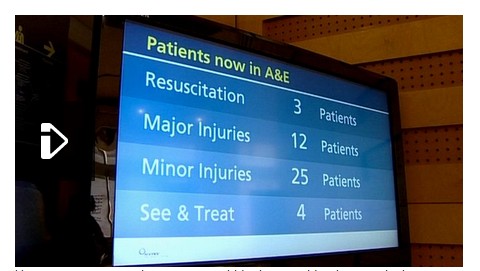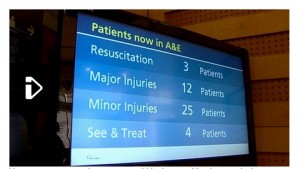This document was compiled in March 2011 by Salma Patel to understand the potential of design interventions to reduce violence and agression in A&E department. The design council recently commissioned a multi-disciplinary design team lead by PearsonLloyd to develop solutions to reduce violence and aggression in A&E departments , and initial results have been reported in the media and the Design Council unveiled the solutions to their challenge last week.
Summary
- There is vast amount of literature that highlights and studies the presence and increase in violence and aggression in A&E departments (or ED), all across the world (e.g. UK, USA, Israel, Iran, Turkey & Australia)
- The impact of violence and aggression on A&E staff has been recorded very widely too.
- There is limited amount of reference/studies of the impact this violence and aggression has on the patient being violent and other patients using the A&E department at the same time.
- Interventions to reduce violence and aggression have also been documented in literature.
- However, references to environmental interventions such as design were found in only a handful of documents, and none of them established through research the impact of environmental interventions on violence and aggression in A&E.
Background
- Violence in emergency departments (ED) is a serious phenomenon that exists worldwide and reports indicate its incidence is increasing (Rose, 1997; Lyneham, 2000; Stirling, Higgins & Cooke, 2001;Winstanley & Whittington 2002; Gacki-smith et al. 2009; Manton 1998; Pawlin 2008; Rayan & Maguire 2006; Stirling et al. 2001; Uzun 2003; Woolam 2007, as cited in Esmaeilpour et al. 2011)
- A systematic review of the literature: workplace violence in the emergency department was conducted by Taylor & Rew (2011) to synthesise the body of literature on workplace violence in the emergency department and to identify characteristics of intervention studies that are the basis for guiding best practice modelling in the clinical setting. They found that incidence of workplace violence in the emergency department has been well documented in numerous published studies and that emergency department workers are exposed to significant rates of physical and verbal abuse.
- Verbal and physical violence are common in emergency departments (Schnieden & Marren-Bell, 1995; Rose, 1997; Jenkin, Rocke, McNicholl & Hughes, 1998; Lee, 2001) but verbal violence is the most common form of violence to which staff are subjected (Brookes & Dunn, 1997; Lyneham, 2000; Crilly et al., 2004). For example, in a retrospective study carried out by Crilly et al. (2004) in south-east Queensland, verbal violence constituted more than half of the violent incidents. (Lau et al. 2004)
- Alcohol-related violence continues to be a significant issue for ED workers and further investigation of policies and procedures around alcohol-related violence in the ED is warranted (Gilchrist et al. 2011)
Impact on staff
- Violence and aggression experienced by emergency nurses has been the focus of international concern. Ferns (2005) examines the phenomena of violence experienced by emergency department nursing staff from an international perspective by reviewing original, published research studies
- Published literature emphasises that violence and aggression experienced by emergency department staff is both a well-recognised and serious issue (Hi- slop and Melby, 2003; Howe and Crilly, 2001, as cited in Ferns 2007). (Chapman & Styles 2006) (Ryan & Maguire 2006) Taylor & Rew (2011)
- A study conducted by Kansagra et al. (2008) showed that violence and weapons in the ED are common, and nurses were less likely to feel safe than other ED staff.
- The impact of aggression is a major reason as to why many nurses leave the profession (Ferns, 2005; Gates et al., 2005, as cited in Rintoul et al. 2009).
- Patient and visitor violence (PVV) is a complex occupational hazard for health care staff working in general hospitals. In order to reduce the deficit of information regarding this kind of PVV, a systematic literature review that describes and summarizes the current scientific knowledge on this topic was conducted. The literature search identified 84 studies (Hahn et al. 2008)
Impact on other patients
- Aggression also spills over onto the lives of other patients in the ED. In an already uncertain environment, being involved in an aggressive incident may exacerbate or prolong their presenting problems. These patients may also become defensive and this instability further distracts staff from their routine work. It leads to increased waiting times and frustration levels in those forced to experience delays in receiving medical and nursing attention (Rintoul et al. 2009)
Interventions to reduce violence in A&E
- An integrative literature review of interventions to reduce violence against emergency department nurses was conducted by Anderson et al. (2010) to critique the evidence that underpins interventions intended to minimise workplace violence directed against emergency department nurses, to inform researchers and policy makers regarding the design, development, implementation and evaluation of emergency nursing anti-violence and counter-violence interventions. The review unambiguously identifies the gap in research products – ‘identifying the lack of evidence’ is ‘an important first step in developing the evidence base’ (Pearson et al. 2007). It is time to redirect the research effort, currently scoping the problem and trying to understand what causes emergency department violence and aggression, to finding out what does and does not fix it (Walsh et al. 2006)
- Results support that violence in the emergency department is increasing, that violence is a major concern for those who work in and visit emergency departments, and that interventions are needed to reduce workplace violence. The Haddon matrix along with an action research method was useful to identify intervention strategies most likely to be successfully implemented and sustained by the emergency departments.(Gates et al. 2011)
- Training health care workers to better cope with violent patients and to avoid injury is becoming standard practice, but research is needed to identify specific aspects of training and patient management pro- grams that are most effective (Wassell 2009)
- Numerous studies have been carried out on the prevalence, causes and nature of violence in emergency departments worldwide, all of which shed light on the problems currently faced in the UK. There have also been a number of studies which have examined the type of security measures introduced in emergency departments over time. In addition, there are abundant articles, editorials and letters in medical and nursing journals highlighting the problem of violence in the emergency setting and suggesting possible solutions to the problem. There have, however, been very few studies which actually assess the effects of various security interventions and systems in reducing violence. (Stirling et al. 2001)
Design of A&E environments as an intervention
- Environmental factors appear to have an influence on whether staff are more likely to experience violence in the workplace. Staff are less likely to experience verbal and physical abuse when factors such as noise, the number of people in close proximity, the working temperature and availability of seating are considered to be good rather than poor. The quality of lighting, the availability of seating and the level of noise are most positively viewed environmental factors (NHS Security Management Service 2010)
- Simple measures that provide the patient or relative with information, such as clear displays of waiting times and comfortable surroundings in which to wait, can relieve the anxiety and tension that may result in aggression. Careful consideration of seating arrangements and décor of the ED can help to reduce stress in those waiting to be treated. Other measures such as providing up-to-date reading material and a TV or Radio within the waiting area can reduce the boredom and frustration so often experienced while waiting in the ED (Dolan & Holt 2007).
Environmental Factors to consider (Dolan & Holt 2007):
- All areas should look clean and welcoming, paying special attention to welcoming areas
- There should be adequate warmth and ventilation
- Noise should be minimised
- Overcrowding should be avoided
- Natural daylight and fresh air should be maximised
- Privacy for patients and staff must be provided
- Clear directions
- Modern literature demonstrates that environmental design interventions have been the most effective in preventing and reducing workplace violence injuries inflicted by strangers in the commission of criminal acts. (Wassell 2009)
- In 1998 The Royal College of Nursing published a guide to dealing with violence against nursing staff, providing a series of recommendations for minimising risk (Royal College of Nursing 1998). Among the areas covered are ‘environmental calming features’ (Stirling et al. 2001)
References
Anderson, L., FitzGerald, M. & Luck, L. (2010) An integrative literature review of interventions to reduce violence against emergency department nurses. Journal of clinical nursing, 19 (17-18), p.pp.2520-30. Available at: http://www.ncbi.nlm.nih.gov/pubmed/20553349 [Accessed March 14, 2011].
Chapman, R. & Styles, I. (2006) An epidemic of abuse and violence: nurse on the front line. Accident and emergency nursing, 14 (4), p.pp.245-9. Available at: http://www.ncbi.nlm.nih.gov/pubmed/17064902 [Accessed March 14, 2011].
Dolan, B. & Holt, L. (2007) Accident & emergency: theory into practice, Elsevier Health Sciences. Available at: http://books.google.co.uk/books?id=3-tFcv9kPAkC.
Esmaeilpour, M., Salsali, M. & Ahmadi, F. (2011) Workplace violence against Iranian nurses working in emergency departments. International nursing review, 58 (1), p.pp.130-7. Available at: http://www.ncbi.nlm.nih.gov/pubmed/21281305.
Ferns, T. (2007) Considering theories of aggression in an emergency department context. Accident and emergency nursing, 15 (4), p.pp.193-200. Available at: http://www.ncbi.nlm.nih.gov/pubmed/17919912 [Accessed March 14, 2011].
Ferns, T. (2005) Violence in the accident and emergency department–an international perspective. Accident and emergency nursing, 13 (3), p.pp.180-5. Available at: http://www.ncbi.nlm.nih.gov/pubmed/15927470 [Accessed March 14, 2011].
Gates, D., Gillespie, G., Smith, C., Rode, J., Kowalenko, T. & Smith, B. (2011) Using action research to plan a violence prevention program for emergency departments. Journal of emergency nursing: JEN : official publication of the Emergency Department Nurses Association, 37 (1), p.pp.32-9. Available at: http://www.ncbi.nlm.nih.gov/pubmed/21237365 [Accessed March 14, 2011].
Gilchrist, H., Jones, S.C. & Barrie, L. (2011) Experiences of emergency department staff: Alcohol-related and other violence and aggression. Australasian Emergency Nursing Journal, 14 (1), p.pp.9-16. Available at: http://linkinghub.elsevier.com/retrieve/pii/S1574626710004027 [Accessed March 14, 2011].
Hahn, S., Zeller, a, Needham, I., Kok, G., Dassen, T. & Halfens, R. (2008) Patient and visitor violence in general hospitals: A systematic review of the literature. Aggression and Violent Behavior, 13 (6), p.pp.431-441. Available at: http://linkinghub.elsevier.com/retrieve/pii/S1359178908000475 [Accessed December 24, 2010].
Kansagra, S.M., Rao, S.R., Sullivan, A.F., Gordon, J. a, Magid, D.J., Kaushal, R., Camargo, C. a & Blumenthal, D. (2008) A survey of workplace violence across 65 U.S. emergency departments. Academic emergency medicine : official journal of the Society for Academic Emergency Medicine, 15 (12), p.pp.1268-74. Available at: http://www.ncbi.nlm.nih.gov/pubmed/18976337 [Accessed January 17, 2011].
Lau, J., Magarey, J. & Mccutcheon, H. (2004) Violence in the emergency department: A literature review. Australian Emergency Nursing Journal, 7 (2), p.pp.27-37. Available at: http://linkinghub.elsevier.com/retrieve/pii/S1328274305800288.
NHS Security Management Service (2010) Violence against frontline NHS staff: Research Study Conducted for COI on behalf of the NHS Security Management Service,
Rintoul, Y., Wynaden, D. & McGowan, S. (2009) Managing aggression in the emergency department: promoting an interdisciplinary approach. International emergency nursing, 17 (2), p.pp.122-7. Available at: http://www.ncbi.nlm.nih.gov/pubmed/19341998 [Accessed March 14, 2011].
Ryan, D. & Maguire, J. (2006) Aggression and violence – a problem in Irish Accident and Emergency departments? Journal of nursing management, 14 (2), p.pp.106-15. Available at: http://www.ncbi.nlm.nih.gov/pubmed/16487422.
Stirling, G., Higgins, J.E. & Cooke, M.W. (2001) Violence in A&E departments: a systematic review of the literature. Accident and emergency nursing, 9 (2), p.pp.77-85. Available at: http://www.ncbi.nlm.nih.gov/pubmed/11760628.
Taylor, J.L. & Rew, L. (2011) A systematic review of the literature: workplace violence in the emergency department. Journal of clinical nursing, 20 (7-8), p.pp.1072-85. Available at: http://www.ncbi.nlm.nih.gov/pubmed/20846214 [Accessed March 14, 2011].
Wassell, J.T. (2009) Workplace violence intervention effectiveness: A systematic literature review?. Safety Science, 47 (8), p.pp.1049-1055. Available at: http://linkinghub.elsevier.com/retrieve/pii/S092575350800218X [Accessed March 14, 2011].
Winstanley, S. & Whittington, R. (2002) Violence in a general hospital: comparison of assailant and other assault-related factors on accident and emergency and inpatient wards. Acta psychiatrica Scandinavica. Supplementum, (412), p.pp.144-7. Available at: http://www.ncbi.nlm.nih.gov/pubmed/12072147.


Comments